|
|
Lavender-Waxbills Estrilda caerulescens (Vieillot, 1817)
Authors (Gerhard Hofmann, Fernanda Scheffer & Claudia Mettke-Hofmann)

For many aviculturists Lavender-Waxbill is without doubt among the most fascinating and attractive Estrildian finches. In the past, the species was readily available and as imports also cheap. As a consequence only few breeders invested their time and devotion to successfully breed this species. In Germany you could get a pair for around € 20,- and so there was no demand for more birds born in captivity … the supply seemed to be endless and every year new birds were brought in from Africa. The situation changed dramatically after the import-ban. Today the species is among the rarities and the demand for it is high. Now it is up to us aviculturist to go the same way we managed to 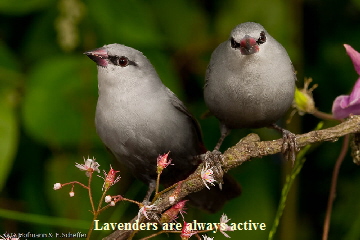 do with so many Australian finches … establish a sustainable population in captivity. As Lavenders are more difficult to breed than most of their Australian relatives this is not an easy task and a long way to go but it is well worth the effort and it is possible. do with so many Australian finches … establish a sustainable population in captivity. As Lavenders are more difficult to breed than most of their Australian relatives this is not an easy task and a long way to go but it is well worth the effort and it is possible.
Lavender Waxbill doesn’t form any subspecies. According to NICOLAI et al. (2007) the species’ distribution in Western-Africa spans from Senegal to the Central-African Republic and in the north up to Saint-Louis in Gambia. It occurs from Guinea-Bissau eastwards to Mali, is rare in Burkina Faso in the Yatenga region but pretty common near Ouagadougou. In Niger it is a common bird in the West-nationalpark and the same is the case in northern Ghana, whereas it is less common in Togo. In northern Nigeria you find the species from the Kainji lake-nationalpark to Kaiama in the north up to Zaire. There is also a small established population in Hawai, founded by escaped birds.
Lavender waxbills inhabit scrubby grassland and like to stay in the shorter grass along forest-edges, creeks and dense scrubby areas. They can also be spotted between rocks , in Mali they can be found in areas with Pteleopsis habeensis and Acacia macrostachya (DUHART & DESCAMPS 1963). Even in the wild Lavender-Waxbills aren’t shy birds and can be found pretty close to humans inhabiting orchards, plantations or roadside vegetation. In Nigeria they like wetlands with Raphia, but also forested areas and scrubland at the base of the isle-mountains.
Usually they can be spotted as small flocks consisting of six to eight, sometimes 20-30 birds. They also hang around with Black-rumped waxbills and Red-cheeked Cordonbleus but in contrast to these two species Lavenders spend more time in the tree top. When they search for food they are immensely active and agile exploring scrubs, tall grass and also ground vegetation. No twig is too thin and no scrub too dense for these little avian jewels.
Sadly there is not much information about nutrition in the wild. NICOLAI et al. (2007) mention grass seeds, small berries and fruits as well as insects as food in the wild.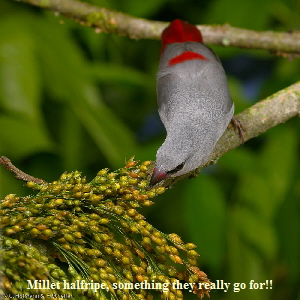
Lavender Waxbills look like delicate birds but when they are born in captivity or wild caught but accustomed to captivity they are quite hardy. The biggest problem in former times was that most of the imported birds didn’t arrive in the best healthy condition, whereas other species which were shipped together with them like Orange-cheeked or Black-rumped Waxbills arrived in a much better condition. The reason maybe that Lavenders eat more insects and fruits as well as a little nectar and pollen and are more sensitive to cold temperatures than their relatives. What doesn’t make things easier is the fact that they –as one of the few African waxbills- are very prone for air-sack mites (KNEER, HOFMANN in NICOLAI et al. 2007). Often these parasites are fatal but only months after the birds got infected. It is likely that the birds are not adapted to this parasite (mainly known from Gouldians) and that they get infected when they arrive at the importer or at the breeder. Beside the typical symptoms like sneezing and breathing difficulties, KNEER (in NICOLAI et al. 2007) describes that his birds lost nearly all feathers in the head region. Sure enough after he treated his birds with Ivermectin the feathers came back. Our own observations can confirm this - we bought several bold headed Lavenders all but one had air sack mites and all but this bird got their feathers back.
Sadly they are, should we say of course, also vulnerable to the more common diseases of our birds like coccidioses, trichomonas or E.coli…. this doesn’t make acclimatization easier and to make things worse quite high numbers were infected with tape-worms. Tape-worms can often be found with birds housed in outdoor aviaries or feed with insects from the wild. Well most of these problems no longer exist as there seems to be no chance that we will get this large number of imports again – I have to say I am not really unhappy about it. Now many birds get the attention they deserve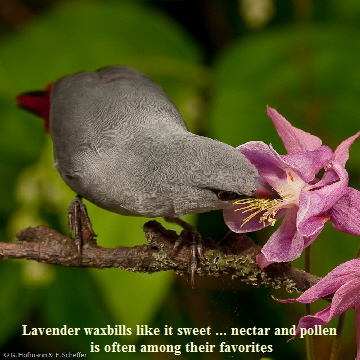 . .
Lavender Waxbill are probably the most trusting Estrildians and are usually never afraid of humans, they are also extremely active and curious as well as very social. Together with their elegance and beauty this makes it our number one Estrildian.
Of course such birds deserve a well structured and planted aviary. They really suffer in the standard breeding- cages. A well structured indoor-aviary or a planted outdoor-aviary with a connected heated indoor enclosure is of course the optimum. Even more important than the size of the cage or aviary is the fact that the cage really should be structured. Lavender definitely suffer in the famous breeding cages equipped with three perches a nest-box and water and food. There is no chance for them to satisfy their desire for exploration, no way to live their life under semi-natural conditions -the only thing left to do is to reproduce. If you have to house the birds in a cage do them a favor and use one that is big enough (>1,20 x 0,60 x 0,60 m) and structure it. We divided our cages in a breeding corner with either artificial plants around the nesting place, or by providing one dense scrubby corner consisting of thuja, spruce or broom (Cytisus scoparius). The other part of the cage contained grass and reed in which the birds loved to climb and feed on the seeds. In spring we regularly offered twigs from willows and fruit trees and the birds were feeding on the buds or the blossoms of these twigs. Lavenders really benefit from environmental enrichment which keeps them occupied for most of the day. Such birds will rarely pluck their mates or themselves which is not so uncommon among Lavenders housed under deprived conditions.
 |
Lavender Waxbills were among the few Estrildians I kept in a cage and let them explore my whole student-room. They had no problems to find the way back to the cage and actually they were successfully breeding under this condition, but I don’t recommend it. The danger that they get trapped behind some furniture or get killed by another accident is fairly high. There is a big difference between a habitat suitable for us humans and the one suitable for Lavender Waxbills.
In terms of nutrition Lavender Waxbills are the perfect mate for creative chefs nearly no other Waxbill has such a broad diet. Most species are happy with a diet consisting of a good standard seed mixture for waxbills and some mealworms, but Lavender Waxbills are gourmets. They happily go for the five courses menu with a seed-mixture consisting of small millet and grass-seeds, insects mixed with egg food, half ripe-seeds, greens, a little bit of sweet fruits and as desert some dry-nectar (recipe at the end). They are really no complicated birds and usually accept new food without too much hesitation but as a real generalist they depend on a certain amount of variation in their diet. Luckily their curiosity helps them to accept new food quite quickly.
The base nutrition for our birds was a mixture of small seeds like senegal-, manna-, mohair-, and some Japanese-millet and very little canary seeds but quite a lot of orchard and meadow grass seeds. A very suitable mixture for most waxbills is the mixture of the German food supplier BLATTNER called Mischung fuer Astrilde (mixture for waxbills). We added some meadow- and orchard-grass, Manna- and mohair-millet. Half-ripe seeds from spray or white-millet and in particular a variety of grass-seeds like meadow- and orchard grass are very popular among Lavenders and play an important role during the breeding season. When the birds have to rear chicks we feed a lot of these seeds preferably grass-seeds followed by spray- and white-millet. But one has to pay attention as some birds develop a strong preference for one or the other seed. Some would feed only on half-ripe spray-millet if it would be enough available. As often in life less is better than too much and we usually force them to not only feed on their favorite food. As with most waxbills we reduce the availability of bigger dry seeds during the breeding season.
.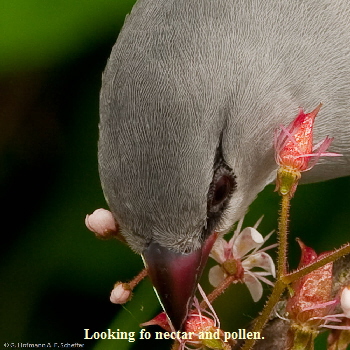
Dry-nectar is a favorite food among many of our Lavender Waxbills and even imports are accepting it very quickly and most birds use a large amount of it when they rear their young. During the non-breeding season our birds have very limited access to this highly nutritional delicacy – with unlimited access you have the danger that they gain too much weight. During the non-breeding season, we also limit access to sweet fruits, live insects, egg food and half-ripe and germinated seeds. After all the species lives in a highly seasonal environment and is well adapted to fluctuations in food availability – actually, it is depending on this change in its life-cycle.
All our Lavenders immediately inspect fresh twigs with buds and blossoms. They go for the little nectar and pollen the blossoms provide and of course they are looking for insects. It is fair to say that these twigs don’t play a big role in their nutrition but are a perfect and highly welcome environmental enrichment. I hate to compare the behavior of birds and humans but when the birds saw us approaching the aviaries with flowering twigs they strongly reminded us of kids waiting for the moment when they can open their birthday gift.
Live-food is very important especially for rearing the chicks. Luckily Lavender Waxbills accept nearly everything. The last two years we mainly offered frosted insects like ant puppaes, mealworms, Pinkies and Buffalos to make them easier digestible. All the frozen live-food but the ant puppaes was cut and mixed with egg-food. Birds housed in outdoor-aviaries catch nearly every invertebrate they can get. They preferable go for small caterpillars, small spider as well as small moths. They are pretty successful in hunting for insects and as there are never enough in the aviary we installed small UV lights or just plain normal 8Watt neon tubes in our outdoor-aviaries. They attract quite a few critters and the first thing the Lavender do in the morning is searching for these nocturnal guests. They also use this opportunity in the evening at twilight and are hunting near these lamps for small insects. Lavender Waxbill can easily be habituated to new food; egg- or soft-food normally gets accepted rather quickly and when it is mixed with grass-seeds and a little bit of dry nectar they accept it even faster. During the breeding season ,our birds get at least daily and if possible three times a day half-ripe seeds, germinated seeds, and egg food mixed with frozen insects. They always have access to our dry seed mixture as well as dry-nectar. A seasonal feeding scheme seem to be very beneficial for the birds; the goodies offered daily during the breeding season as well as the dry nectar is dramatically reduced during the non breeding season. It helps a lot to simulate the annual rhythm and we never had problems with unfertile clutches. All year round our birds have access to minerals consisting of Grit, clay-block, and sterilized crushed egg-shells as well as to bird-soil or ‘Ferkelwuehlerde’ (a special soil used when rearing piglets to stabilize their digestive tract). To prevent egg-binding we start around to powder the dry seeds with Nekton MSA (Calcium and Vit D3) four to six weeks before the expected laying date. So far we never ever had a Lavender female with egg-binding. 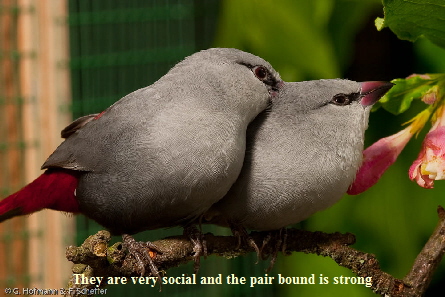
Lavender Waxbills normally sleep in nests; mostly they use unoccupied old nests of other species or weaver nests. Luckily they don’t tend to lay clutch after clutch when they have a nest in their aviary. Similar to the location of the breeding nest the bird prefer high, well protected and hidden places for their sleeping nests. The birds use a large variety of nesting material from dry grass, over coconut fibers, moss, leaves, and stripes of paper as well as old empty spray millet. If they have the opportunity nearly all our pairs erect their nests in dense vegetation. But they don’t line the nest with white feathers like most fire-finches or the blue waxbills do. What they do is using the finer material for the inner layer of the nest. All our pairs build nests with a long, downwards pointing entrance tube but there is huge variation in the length of this tube. Even nests from the same pair can show large variation in the length of this tube. There is a tendency that younger males build shorter tubes. When Lavender Waxbills want to enter the nest they approach with a swift direct flight from below and usually announce with a soft whistle to their mate that they came. The same sound can be heard when the nestlings are fed by their parents. This seems to be the way to communicate in the totally dark nest chamber. When we had nestlings out of the nest to ring them they immediately opened their bill when they heard this whistle from their parents. But there was no way convincing them to open their bill with all the other methods (tipping at the bill, slightly tapping the nest…) which are usually used for inducing this behavior. Maybe in the totally dark nest chamber the whistle is a safer way to signal that there isn’t a predator approaching but one of the parents.
Sometimes Lavender Waxbills take over old nests from other species. They only refurbish them by attaching their typical entrance-tube and are ready to go. Some even are squatters; several times one of our pairs took over the nest of our Swee-Waxbills so that they had to build a new nest whereas the Lavenders were already breeding in the Swee’s old nest. Usually they build a cocknest. Of course, when they have to use a standard nest box it is not possible, but if they are allowed to build their nest in dense vegetation they will erect it. Cocknests are often decorated with a large variety of conspicuous items like eggshells, crumps of dark soil, and even dried and mummified small nestlings. The reason why they build these cock-nests and decorate it the way they do is still not clear.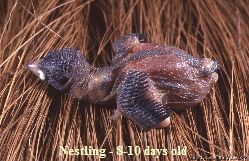
Lavender Waxbills are usually very reliable in incubating their clutch; we never had problems that the chicks didn’t hatch. The average clutch size is three to five eggs, similar to the their close relative the Black-tailed Waxbill. Lavender Waxbill females which don’t get enough live-food in the pre-laying period tend to have smaller clutches than the ones with a diet with a higher amount of live-food. The parents share the duty while incubating the eggs but as often the female gets to do the bigger part of this job. Our birds never gave up (abandoned) a clutch because we controlled the nest. Nonetheless there is risk involved and we recommend to be extremely careful or to just skip the controls especially when the pair is breeding for the first time. Another rule is not to disturb the birds when they start to incubate, the longer they are incubating the eggs the less likely they will give up the brood.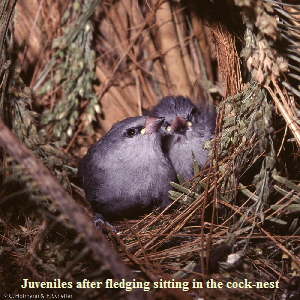
The babies hatch after 13-14 days incubation time. They are light pink with dark grey dunes on the head and back (BIELFELD 1996). As soon as they are hatched the parents show a dramatic change in their behavior and suddenly get even more active in searching for insects and tiny half-ripe seeds. The first seven days are usually the most critical time for success - if the parents don’t find enough suitable food they will reject their offspring and the breeder will find the chicks dead on the floor of the aviary. The protein source our birds like most are ant-puppaes offered either fresh or frozen, followed by tiny wax-moth larvae, frosted and cut in half pinkies as well as white mealworms but of course in outdoor aviaries they nearly go for every insect and spider they can catch. After three or four days they also will feed the first seeds to their chicks; in the case of our birds mainly green grass-seeds (meadow, orchard and ray grass) as well as half-ripe red and yellow spray millet (we usually have enough of the grass-seeds and millet in the freezer for a full breeding season) and a little of the germinated seed mixture we offer. As it turned out that the breeding success was lower when the birds were feeding too many large seeds (white millet for example) to their chicks we make sure that the birds are offered mainly small seeds. Some of our pairs showed a very strong preference for dry nectar (see recipe at the end); actually they were feeding so much of it to their chicks that the content of the crop was totally yellow. During the breeding season we reduce the amount of sugar and increase the amount of NEKTON-Tonic K (4 parts of nectar according to the recipe 1 part TONIC-K). We also really would like to emphasize how badly the influence of large seeds is for breeding success. When we started to breed Lavender we lost several clutches because the chicks were not able to digest the food the parents were feeding them. Beside large dry seeds uncut Buffalos and small uncut brown mealworms seemed to be unsuitable for some of our breeding pairs. Again we had pairs feeding large amounts of it and we found the chicks dead in the nest with a well filled crop. These insects were often found in large amounts in the digestive tract of the dead nestlings virtually not digested at all. Only after we had changed the diet of these pairs and switched from buffalos and small mealworms to ant-puppaes and frozen crushed pinkies these pairs reared their offspring successfully. Other pairs which also had access to buffalos and small mealworms had no problems rearing their babies. As so often it helps a lot to observe and to know the birds.
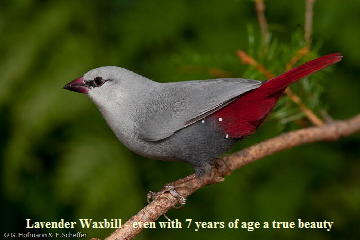
Another important factor for our Lavender Waxbill is the temperature, especially after seven to nine days when the parents stop huddling their chicks. The nestings from parents kept at higher temperatures had fewer problems digesting larger seeds and or hard-shelled insects than nestlings in the outdoor aviary which had serious problems with digesting these food items. This means that the lower the temperature is the more important it is to offer easy to digest food in this period. Usually the youngsters fledge with around sixteen –eighteen days of age but for the next couple of days they mainly stay in the very close vicinity of the nest and often return to the nest for taking a nap or getting fed by their parents. If they fledge way later than 18 days then often the nutrition was not optimal for them, in many cases a deficiency of protein is responsible. This can either mean that there was not enough food provided or the wrong food was provided. But in outdoor aviaries the chicks also will extend their stay in the nest when the weather is cold and wet … a wise decision with our European weather. Similar to their parents the young Lavender are as curious as curious one can be, already few days after fledging the explore their new world outside the nest very thoroughly, they also began feeding on the dry nectar and try to open the first soft, half-ripe seeds. Usually it takes about fourteen days until they are no longer depending on their parents. As the curiosity of the juveniles doesn’t stop at the entrance of the nest where their mother is sitting on the next clutch it is often necessary to separate the juveniles from their parents in particular when the family is housed in cage. If they are housed in a large well structured aviary this is less of a problem, here they have many things to explore and don’t bother their parents with their activities. The start to moult into adult plumage when they are bout six to seven weeks old with an age of three months they have their adult plumage and only can be identified by their slightly smaller size. One important warning at the end Lavender Waxbills can be fearless fighters when they are housed together with other pairs of their species in particular the males get very aggressive. It is nearly impossible to have two breeding pairs in one aviary and often the male gets aggressive against his own sons when they have their adult plumage. To be on the safe side we mostly separated the juveniles when they were around seven to eight weeks old and are starting or are close to start their juvenile moult.
Lavender Waxbills can be quite productive in captivity but therefore they need the correct nutrition and an appropriate housing-condition. In four years we managed to raise 59 juveniles and we never had more than two breeding pairs, these pairs were allowed to raise two clutches per season. It turned out that the birds we raised were as reliable in raising their babies as were there parents which were all born in the wild and breeding them over several generations was no problem either. A promising result for establishing this species in captivity, hopefully there are still enough birds around for a sustainable population in captivity. It would be more than a petty if the Lavender Waxbill would get extinct in captivity. But of course the Lavender would not be to blame for this, it would be the fault of us aviculturists who didn’t take care early enough, there were so many birds around just a couple of years to found a captive population …. actually too many to keep us breeders interested enough.

Recipe for the dry nectar:
- 400 gr Pollen very fine grinded (it is best to grind the Pollen when it is frozen)
- 300 gr Dextrose
- 100 Nekton Tonic K
- 200 gr commercial dry eggfood very fine grinded
2 tea spoon of dry inactive brewing yeast
2 gr Nekton S
2 tea spoons Nekton MSA
- The whole mixture should be a fine powder.
ALT, E.(1965) Zucht von Auroraastrilden und Schönbürzel.AZN. 12, 49-
BAUM, W.(1963)Gelungene Schönbürzelzucht im Gesellschaftskäfig. Gef. Welt 87. 23-
BIELFELD H.(1996)Das Prachtfinkenbuch. Stuttgart. Ulmer Verlag
DIETZ, H.G.(1978) Aufzucht von Schönbürzelchen aus Importen (Estrilda caerulescens).Ziergeflügel und Exoten 181.
Duhart & Descamps (1963): Oiseaux
FRIEDRICH, T.(1980)Schönbürzel (Estrilda caerulescens) Ziergeflügel und Exoten 108
Fry, C. H. & Keith, S(2004): The Birds of Africa , Vol. VII. Christopher Helm, London.
GRUBBE, O.(1967)Schönbürzelbrut im Gesellschaftskäfig. Gef. Welt 91. 104-
GÜTTINGER, H.J. & NICOLAI, J.(1973)Struktur und Funktion der Rufe bei Prachtfinken (Estrildidae).Z. Tierpsychol. 33. 319-334
HARRISON, C.J.O (1962)An ethological comparison of some waxbills (Estrildini) and its relevance to their taxonomy.Proc. Zool. Soc. London 139. 261-282
KULKA, D.(1977) Grundsätze zur Eingewöhnung von importierten Prachtfinken und Zucherfahrungen mit Schönbürzeln (Estrilda caerulescens). Ziergeflügel und Exoten 86
KUNKEL, P. (1959)Zum Verhalten einiger Prachtfinken. Zeitschrift f. Tierpsychologie 16. 302-350
KUNZE, H.D.(1962)Eingewöhnung und Balz der Schönbürzelchen Gef. Welt 86. 209-
MEYER, E.(1965)Zuchterfolge mit Schönbürzel in derVogelstube. Gef. Welt 89.3-
MUNZ, K.(1979)Die Zucht des Schönbürzels. Gef. Welt 103. 102-103
NICOLAI, J.(1963)Zu den Berichten über Seltener Astrild, Schönbürzel,Wellenastrild und Blauer Honigsauger. GW 87:18..
NICOLAI, J. STEINBACHER, J. , van den ELZEN, R., HOFMANN. G., METTKE-HOFMANN, C. (2007) Prachtfinken Afrika. Ulmer Verlag
OCKO(1966) Aufzucht von Schönbürzeln zweiter Generation
in der Zimmervoliere. AZN. 3.13-
OPPENBORN, G. & OPPERMANN, (1982) Oppermann, H. & Oppermann, M. (1982): Uber Zuchterfahrungen mit Schönbürzeln. ZuE 122 Ziergeflügel und Exoten 122
PFEIFFER, U.(1967)Beobachtungen zum Verhalten der Schönbürzel Gef. Welt 91.61-
PFIRTER, A.(1960) Der Schönbürzel.Gef. Welt 84.37-
REICHERDT, C.(1979) Der Schönbürzel, ein gewandter und anmutiger Prachtfink.Gef. Welt 103.12-
SCHIEBE, A.(1992)Das Schönbürzelchen Glauce strilda caerulescens. Ziergeflügel und Exoten 28
SCHIFTER, H.(1961) Gelungene Schönbürzelzuchten in der Zimmervoliere.Gef. Welt 85175-
SCHIFTER, H.(1962)Gelungene Schönbürzelzuchten in der Zimmervoliere.Gef. Welt 86.19-
SCHÖNBORN, C.H.(1982)Schönbürzelchen (Estrilda caerulescens). Einer der liebenswertesten afrikanischen Prachtfinken.Gef. Freund 29.241-
SCHÖNBORN, C.H.(1984)Schönbürzelzucht in der GartenvoliereGef. Freund 31.116-
STENZEL, P.(1960)Stenzel, P. (1960): Meine Schönbürzel als Fernsehfans. GW 84:72.Gef. Welt 84.7-
TATZER, G.(1987) Schönbürzel, Estrilda caerulescens.Akt. a.d. Vogelwelt 1.167-
ZARTH, J.(1977)Beobachtungen und Erfahrungen bei der Haltung und Zucht von Schönbürzel Estrilda caerulescens (Vieill.). Ziergeflügel und Exoten 51.
nicht mehr. Ob es allerdings gelingen wird, die Art in Liebhaberhand zu erhalten, hängt jetzt allein von den Zuchtbemühungen und der Zusammenarbeit der interessierten Züchter ab.
All images and text and are Copyright © 2007 of Hofmann-photography and may not be used without the permission of the authors
|
|